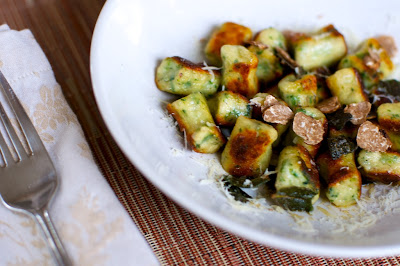GNUDI. SOUNDS like naked. Gnudi are basically ravioli fillings without their pasta clothing. You mix a bit of flour into the cheese filling and shape it into little balls or pillows.
You can serve them boiled, but I like adding one more step and pan-frying the gnudi so that the rich, creamy inside is contrasted by the fried exterior. Finely chopped nettles (or spinach or herbs) add an extra dimension of flavor. It’s up to you how much herbage to add. I didn’t want my gnudi to be overpowered by the nettles, so I limited mine to a scant, loose cup; you could double that amount and end up with much greener, woodsier gnudi.
2 cups ricotta
3/4 cup grated parmesan
2 eggs
1 cup boiled and chopped nettles
1/2 cup flour, plus more for rolling
1/8 tsp nutmeg
salt and pepper
olive oil
butter
fresh sage, chopped
1. Blanche stinging nettles in boiling water for a minute. Drain, shock with cold water, and squeeze out as much excess water as possible. Chop finely to fill a loose cup.
2. Drain ricotta and stir into large bowl with parmesan, eggs, chopped nettles, a dash of nutmeg, and seasoning. Slowly add flour. Mixture should be damp and tacky without sticking to hands. If a half cup of flour doesn’t do the trick, keep adding a little more at a time until you can form a wet ball in your hand without it adhering.
3. Sprinkle work surface generously with flour. Take a snowball-sized handful of cheese mixture and roll in flour until thoroughly coated. Roll out into a snake with a half-inch to inch diameter depending on preference. Cut into pillows. Dredge the cut ends in flour and shape each pillow as desired. Set aside on floured plate.
4. Boil gnudi in batches in salted water. They’re done when they float to the surface. Use a slotted spoon to remove from boiling water to a clean plate. Place cooked gnudi on wax paper on a cookie sheet. I like to boil a batch after each snowball’s worth of filling is shaped. While that batch is boiling (it only takes a couple minutes), I move the previous boiled batch from plate to wax paper. Then I continue with another handful.
5. Pan fry gnudi in olive oil and butter with chopped sage leaves until nicely browned. Leftover boiled gnudi can be refrigerated.
Nettle Gnudi with Lamb Ragu, Carrot Puree & Sage Butter Crumbs
For a more involved dish I made a lamb shoulder ragu by browning diced lamb shoulder in olive oil with shallot, deglazing with a splash of white wine, and stirring in a teaspoon of tomato paste. This got served over the pan-fried gnudi along with a sauce of pureed stewed carrots and a sprinkling of sage butter crumbs.
Gnudi are easier to make than potato gnocchi, and the melt-in-your-mouth inside is a truly wonderful thing. Another reason to get yer weed on.














